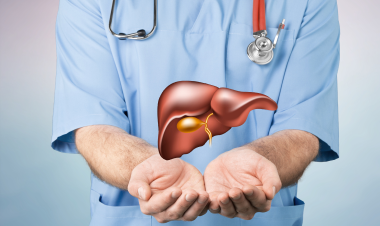Fatty liver disease, known as hepatic steatosis, happens when too much fat accumulates in your liver cells. This condition usually doesn't cause symptoms in the early stages, but if left untreated, it can lead to more severe liver problems.
Symptoms of Fatty Liver Disease
-
Fatigue: Persistent tiredness and a lack of energy are common complaints among individuals with fatty liver disease. The liver's compromised ability to process nutrients and filter toxins can lead to overall feelings of weakness and exhaustion.
-
Sudden Weight Loss: Some people with fatty liver disease may experience sudden weight loss, even without changes in diet or exercise.
-
Abdominal Discomfort: Another common symptom of fatty liver disease is discomfort and pain in the upper abdominal region.
-
Jaundice: Jaundice may develop in more advanced cases of fatty liver disease.
-
Swelling and Fluid Retention: Fatty liver disease can lead to fluid accumulation in the abdomen, a condition known as ascites.
Causes of Fatty Liver Disease
-
Dietary Factors: Diets high in saturated fats, refined sugars, and processed carbohydrates contribute to weight gain and fat accumulation in the liver.
-
Obesity and metabolic syndrome: Obesity is a leading risk factor for fatty liver disease. Excess body fat, especially around the abdomen, increases the likelihood of fat deposition in the liver.
-
Genetics: Genetic factors can play a role in determining an individual's susceptibility to fatty liver disease. Some people may have genetic variations that affect how their bodies metabolise and store fat.
-
Alcohol Consumption: Chronic and excessive alcohol consumption can lead to alcoholic fatty liver disease.
-
Rapid Weight Loss: Sudden and significant weight loss, often associated with crash diets or bariatric surgery, can rapidly release stored fat into the bloodstream.
Diagnosing Fatty Liver Disease
Diagnosing fatty liver disease involves a combination of medical history assessment, physical examination, blood tests, imaging tests, and, in some cases, a liver biopsy.
Here's a breakdown of the diagnostic process:
-
Medical History and Physical Examination: Healthcare providers begin by taking a detailed medical history, including inquiries about lifestyle, alcohol consumption, and known risk factors.
-
Blood tests: Blood tests are instrumental in assessing liver function and diagnosing fatty liver disease.
-
Liver Function Tests: These measure the levels of liver enzymes, including alanine transaminase (ALT) and aspartate transaminase (AST).
-
Ultrasonography: Ultrasonography is often the first-line imaging technique for detecting fatty liver. It can reveal the presence of fat deposits in the liver.
-
Computed Tomography (CT) Scan and Magnetic Resonance Imaging (MRI): These imaging techniques offer detailed views of the liver and can help assess the extent of liver damage and fibrosis or cirrhosis.
-
Liver Biopsy: In some cases, a liver biopsy may be recommended to confirm the diagnosis and assess the extent of liver damage.
Treatment for Fatty Liver Disease:
The treatment of fatty liver disease primarily revolves around lifestyle modifications and managing underlying conditions that may contribute to the condition.
Here's a comprehensive overview of the treatment strategies:
Lifestyle Changes
-
Dietary Modifications: Adopting a healthy diet is fundamental to managing fatty liver disease.
-
Weight Management: If overweight or obese, gradual and sustainable weight loss is crucial.
-
Physical Activity: Regular exercise is essential for burning excess fat, improving insulin sensitivity, and improving overall health.
-
Alcohol Avoidance: For individuals with alcoholic fatty liver disease (AFLD), abstaining from alcohol is paramount to preventing further liver damage.
Weight loss surgery
In severe cases of obesity-related fatty liver disease, weight loss surgery (bariatric surgery) may be recommended. It can substantially improve liver health by promoting significant weight loss.
Management of Underlying Conditions
If fatty liver disease coexists with conditions like diabetes, high blood pressure, or high cholesterol, effective management of these conditions is crucial. Medications, lifestyle changes, and regular monitoring are essential.
Regular monitoring
Individuals diagnosed with fatty liver disease should have regular check-ups with their healthcare providers to monitor liver function, track disease progression, and make necessary adjustments to the treatment plan.
Liver Transplantation (rare)
In extremely rare cases where fatty liver disease progresses to advanced liver cirrhosis or liver failure, a liver transplant may be considered when all other treatment options have been exhausted.
Prevention of Fatty Liver Disease
Here are key strategies for preventing fatty liver disease:
-
Adopt a Healthy Diet: Adopting a balanced diet is crucial for managing fatty liver disease.
-
Regular Physical Activity: Regular physical activity helps burn excess fat, improve insulin sensitivity, and promote overall health.
-
Maintain a Healthy Weight: For individuals with obesity, losing weight through gradual, sustainable methods is crucial. Even a modest weight loss of 5–10% of body weight can significantly improve liver health.
-
Keep Alcohol Consumption in Check: Excessive alcohol consumption can lead to alcoholic fatty liver disease (AFLD). It's essential to abstain from alcohol completely to prevent further liver damage.
-
Manage Underlying Conditions: If fatty liver disease is associated with diabetes, high blood pressure, or high cholesterol, it's crucial to manage these conditions effectively through medications, lifestyle changes, and regular monitoring.
-
Regular Check-ups: Individuals with fatty liver disease should have regular check-ups with their healthcare provider to monitor liver function, assess disease progression, and adjust treatment plans as needed.
Conclusion:
Fatty liver disease is when excess fat accumulates in the liver, potentially leading to liver inflammation and damage. With its renowned team of specialists and state-of-the-art facilities, Saroj Super Speciality Hospital offers the best treatment for this ailment.
FAQs About Fatty Liver Disease
Q1. What are the three major signs of a fatty liver?
A1. The three common signs of a fatty liver are fatigue, unexplained weight loss, and abdominal discomfort.
Q2. Is fatty liver a serious condition?
A2. Fatty liver can be a serious condition, especially when it progresses to non-alcoholic steatohepatitis (NASH) or cirrhosis. Early detection and lifestyle changes are crucial for preventing complications.
Q3. What are the common symptoms of fatty liver disease?
A3. Common symptoms include fatigue, unexplained weight loss, abdominal discomfort, and elevated liver enzymes. However, fatty liver disease can often be asymptomatic in its early stages.
Q4. What are the treatment options for fatty liver disease?
A4. Treatment focuses on lifestyle changes, including dietary modifications, regular exercise, weight management, and alcohol abstinence. In certain cases, medications or weight loss surgery may be considered.



